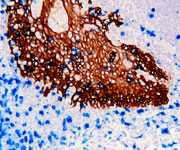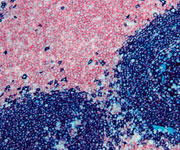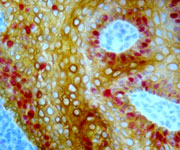The human immune system is one of our strongest lines of defense against the countless diseases that exist all around us. When our immune system is compromised, our rate of survival is very much decreased. T cells and B cells are the major components of our adaptive immune system. T cells are involved in cell-mediated immunity whereas B cells are responsible for producing antibodies necessary to fight off infections. The antibodies stick to antigens on the surface of the germs that come into our bodies, stopping them by creating clumps that alert us to the presence of these intruders. Lymphoma is the most common form of hematological malignancy. It occurs when cells of the immune system begin to behave abnormally and grow and multiply uncontrollably. These abnormal lymphocytes can travel to many parts of the body, including lymph nodes, spleen, bone marrow, blood and other organs where they can form cancerous tumors, crippling our immune system. One type of lymphoma is Diffuse Large B cell Lymphoma (DLBCL), which is defined as a diffuse proliferation of large neoplastic B lymphoid cells that destroys the pre-existing design of the cells. It is extremely aggressive and is the most common form of non-Hodgkin lymphoma. It accounts for nearly 30% of newly diagnosed cases in the United States (Lymphoma Research Foundation). Diffuse large B cell lymphoma can arise in the lymph nodes or outside the lymphatic system. Recent studies have subdivided DLBCL into some morphologically, biologically, or clinically distinct disease entities. However, a large amount still remains mixed. About half of the patients with DLBCL achieve long term remission. Unfortunately, for the rest of these patients, the therapies used are sometimes unsuccessful. New and innovative treatment strategies that are grounded by underlying molecular oncogenic mechanisms, are therefore needed.
A study was conducted by Junichi Kiyasu and colleagues at Kurume University School of Medicine to determine the signs and symptoms directly associated with the expression of Programmed cell death ligand (PD-L1) in DLBCL patients. This study performed PD-L1/PAX5 double immunostaining in 1,253 DLBCL biopsy samples. PD-L1 is expressed on both select diffuse DLBCL tumor cells and tumor-infiltrating benign tumor cells, and was found to inhibit host antitumor responses. However, very little is known about its functions in the tumor’s microenvironment. Diseases associated with PAX5, a protein coding gene, include precursor B cell acute lymphoblastic leukemia and leukemia. Using Enzo Life Sciences’ POLYVIEW® IHC reagent (mouse-AP) and HIGHDEF® red IHC chromogen (AP, plus) for visualization of PAX5, the researchers determined that thirty percent of the lymphoma cells exhibited distinct membranous and/or cytoplasmic staining of PD-L1 and nuclear staining of PAX5. The study provided proof that PD-L1 expression on tumor cells was an autonomous prognostic factor for overall survival in patients with DLBCL by means of PD-L1/PAX5 double staining. It also suggested that the PD-1/PDL1 pathway contributed to the DLBCL tumor microenvironment and could be an effective therapeutic target. IHC double staining technique is a useful and cost-effective method for recognizing and distinguishing PD-1/PD-L1+ patients. The study also found that when PD-L1 is expressed on tumor cells, it plays a critical role in the DLBCL tumors’ microenvironment, resulting in a poor prognosis. The number of PD-1+ tumor-infiltrating lymphocytes was significantly associated with PD-L1 positivity of lymphoma cells and tumor-infiltrating non-malignant stromal cells. Blocking of the PD-1/PD-L1 pathway using monoclonal PD-L1 antibodies may be an innovative and effective treatment approach for patients with DLBCL. Future studies are necessary for additional information on whether expression of PD-L1 on tumor cells or on other benign cells is a key factor linked with clinical outcomes in Diffuse Large B cell Lymphoma.
Enzo Life Sciences offers a comprehensive product portfolio for advancing your discoveries in
immunohistochemistry research including our POLYVIEW® IHC reagents and HIGHDEF® IHC chromogens. In addition, Enzo offers an array of kits, dyes and labels for all of your IHC needs, some of which are detailed below.











